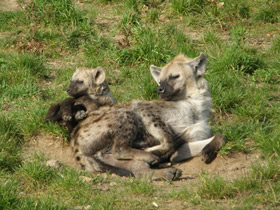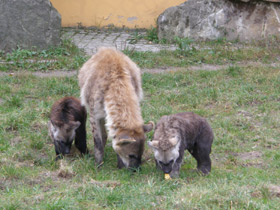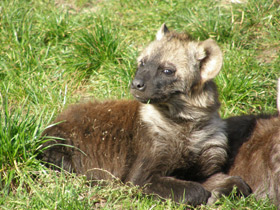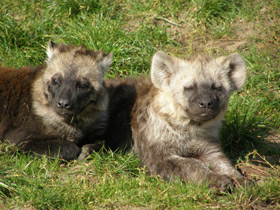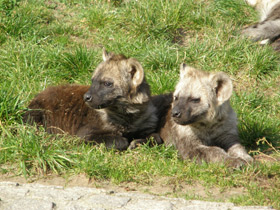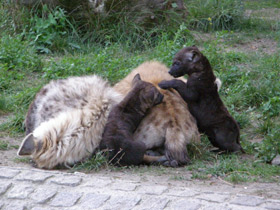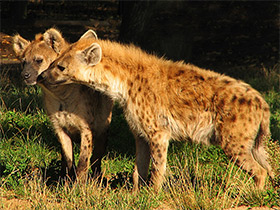The spotted hyena (Crocuta crocuta), also known as the laughing hyena
Spotted hyena видео
The spotted hyena (Crocuta crocuta), also known as the laughing hyena, is a hyena species, currently classed as the sole extant member of the genus Crocuta, native to sub-Saharan Africa. It is listed as being of least concern by the IUCN due to its widespread range and large numbers estimated between 27,000 and 47,000 individuals. The species is, however, experiencing declines outside of protected areas due to habitat loss and poaching. Populations of Crocuta, usually considered a subspecies of Crocuta crocuta, known as cave hyenas, roamed across Eurasia for at least one million years until the end of the Late Pleistocene. The spotted hyena is the largest extant member of the Hyaenidae, and is further physically distinguished from other species by its vaguely bear-like build, rounded ears, less prominent mane, spotted pelt, more dual-purposed dentition, fewer nipples, and the presence of a pseudo-penis in the female. It is the only placental mammalian species where females lack an external vaginal opening, having a pseudo-penis instead.
Appearance and habitat
Crocuta crocuta is a species of carnivorous mammal of the family Hyaenidae. Crocuta crocuta is the largest of the scavenging mammals, measuring 95-166 cm in length and 80 cm at the withers, and weighing 60-80 kg, with females being surprisingly larger than males. The species inhabits deserts and savannahs south of the Sahara.
Nutrition
Crocuta crocuta is an extraordinarily efficient scavenger: its digestive system and highly acidic gastric juice allow it to use almost any part of another animal's body, including its skin, horns, large bones and even faeces. Crocuta crocuta is able to satisfy its hunger even with dead cousins in the last stages of decomposition. Food digestion is so complete that Crocuta crocuta droppings almost never decompose, have the appearance of chalk and are composed mainly of calcium phosphate.
It was believed that Crocuta crocuta were mainly content with the remains of prey from other predators, but special studies have shown that they are excellent hunters in their own right, in some cases even surpassing lions. In 4 out of 5 cases, Crocuta crocuta hunt themselves, attacking antelopes, zebras, buffalo and other ungulates. They also feed on various small mammals, reptiles, insects, bird eggs, as well as vegetables and fruits.
Social behaviour and reproduction
Crocuta crocuta live in family groups, clans, in which there is a strict separate hierarchy between males and females; however, even the lower-ranking females always dominate the males. In a cave or a dug hole, the female gives birth to up to 7 cubs. Unlike the young of most raptors, they are born showy and toothy, and covered with short, monochrome, unspotted fur. The unusual aggressiveness of female Crocuta crocuta crocuta begins in early infancy: if there are two females in a brood, they fight constantly, and in the end the weaker one dies. The Crocuta crocuta's milk is so nutritious that the cubs can go for up to a week without eating after feeding. They remain on a milk diet for up to two months, and then begin to eat meat. Both parents are involved in raising the pups, but the female is more careful. Daughters usually follow their mother in the hierarchy, while older males move on to another clan.

















